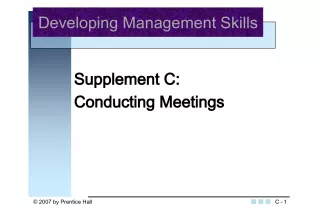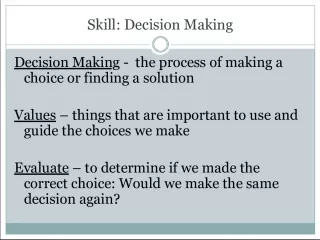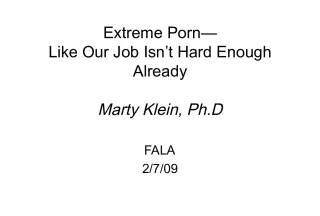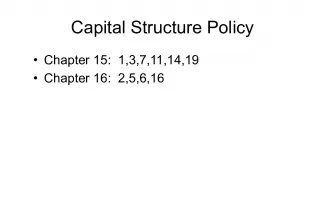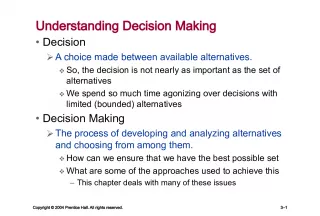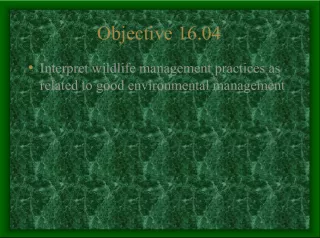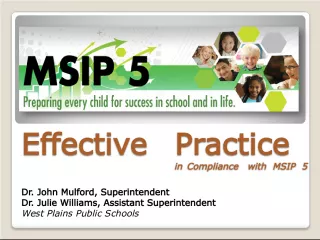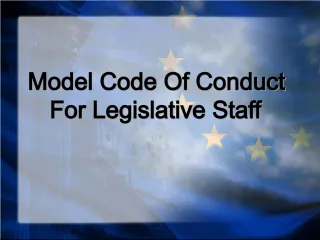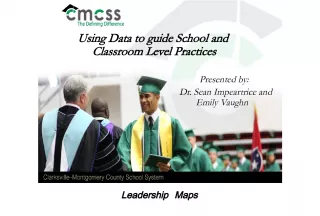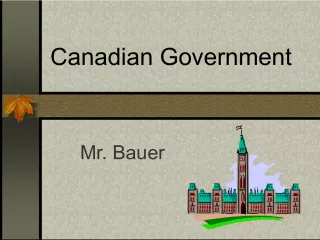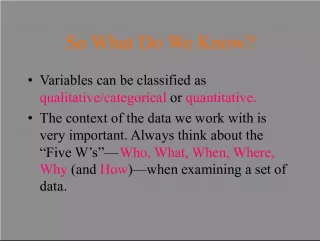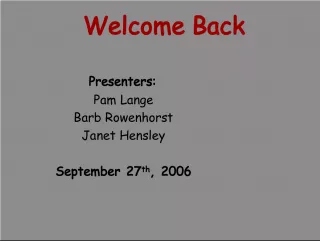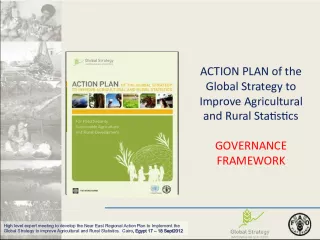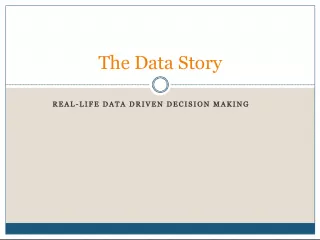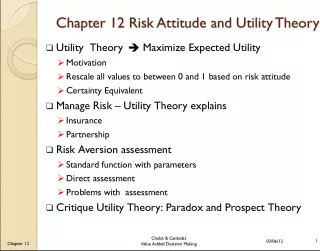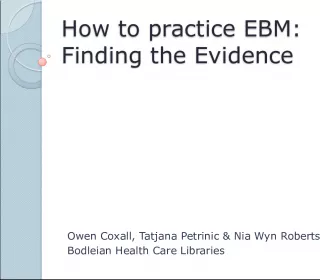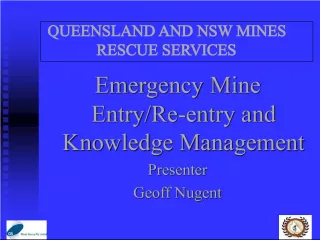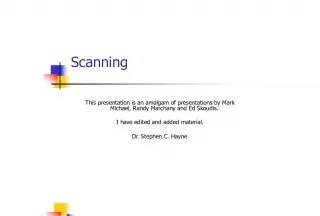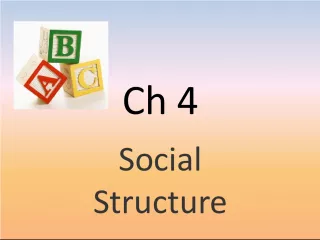Effective Meeting Management: A Guide to Committee Structure, Decision Making and Staff Liaison Best Practices
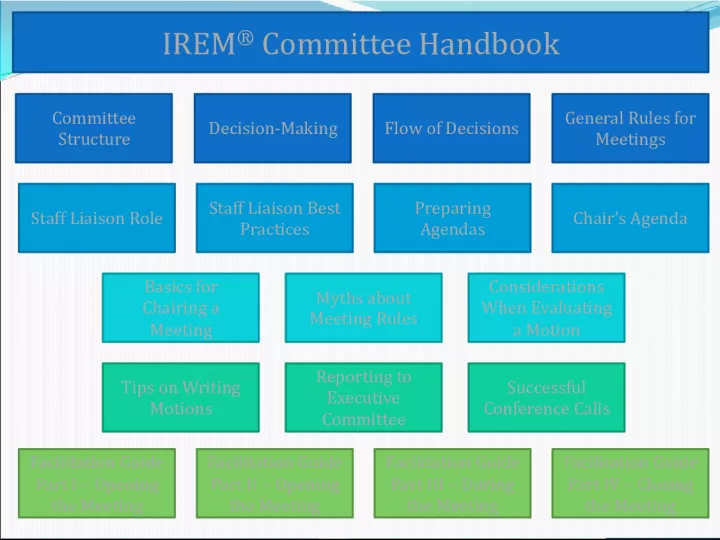

This guide provides practical advice on how to effectively manage different aspects of meetings, including committee structure, decision making, staff liaison role, preparing agendas, and following general meeting rules. Whether you're a chairperson, staff liaison, or just a participant, this guide offers useful tips and insights on how to ensure successful conference calls or in-person meetings.
- Uploaded on | 18 Views
-
 jams
jams
About Effective Meeting Management: A Guide to Committee Structure, Decision Making and Staff Liaison Best Practices
PowerPoint presentation about 'Effective Meeting Management: A Guide to Committee Structure, Decision Making and Staff Liaison Best Practices'. This presentation describes the topic on This guide provides practical advice on how to effectively manage different aspects of meetings, including committee structure, decision making, staff liaison role, preparing agendas, and following general meeting rules. Whether you're a chairperson, staff liaison, or just a participant, this guide offers useful tips and insights on how to ensure successful conference calls or in-person meetings.. The key topics included in this slideshow are Meeting management, Committee structure, Decision making, Staff liaison, Meeting rules, Agendas preparation, Conference calls, Meeting myths, Motion evaluation, Executive reporting,. Download this presentation absolutely free.
Presentation Transcript
1. Committee Structure Decision-Making Successful Conference Calls Basics for Chairing a Meeting Myths about Meeting Rules Considerations When Evaluating a Motion Flow of Decisions Staff Liaison Role Tips on Writing Motions Reporting to Executive Committee Preparing Agendas Chairs Agenda Facilitation Guide Part I Opening the Meeting Facilitation Guide Part III During the Meeting Facilitation Guide Part II Opening the Meeting Facilitation Guide Part IV Closing the Meeting Staff Liaison Best Practices General Rules for Meetings IREM Committee Handbook
2. Committee Structure Standing Committees Develop policies and provide guidance for IREM programs. Implementation and Advisory Boards Work with IREM programs that require member participation and/or oversight. Forums Provide educational and networking opportunities at IREMs national conferences. Ad Hoc Groups May be formed for the purpose of completing specific tasks. Reporting Standing Committees report to the Executive Committee. All decisions of standing committees are made in the form of a recommendation to the Executive Committee. Advisory boards submit written reports to the Executive Committee for informational purposes only, unless there are decisions outside the boards scope requiring further approval. Committee Service Committee and Board Chairs, Vice Chairs, members, and Forum co-leaders are appointed annually by the incoming president. Terms are for one year unless otherwise noted. Individuals may only serve on one standing committee; however, they may serve on additional boards or ad hoc groups. All members CPM, ARM, ACoM, CPM Candidate, Associate, Student, and Academic are eligible to serve on all committees and boards, although Associates, Student, and Academic Members serve without vote. Non-IREM Members who may be invited to serve on an IREM committee, do so without vote. Committees and Boards typically meet at IREM national meetings, which are the Leadership and Legislative Summit and the IREM Fall Leadership Conference, and by conference call or webinar at other times during the year Learn more about each of IREMs Committees, Boards, and Forums http://www.irem.org/about- irem/volunteering/committees Return to main menu
3. Decision-Making IREM strives to incorporate association management best practices into its governance thinking and operations using ASAE as its primary resource for knowledge and networking. IREM committees are encouraged to use a knowledge-based decision-making model for exploring, analyzing, and ultimately acting on issues that come before them. Four stages of knowledge-based decisions 1. Information Gather the facts Informal research Formal research Scanning 2. Dialogue Initial phase, illuminates the issue What do we know? dont know? Based on desired outcome, what could we do? what else could we do? What are the merits/considerations for each alternative? Use I statements (See Own Your Idea below.) 3. Deliberation Debate the issue Speak in favor Speak against Roberts Rules apply here 4. Decision Vote on the issue Own Your Idea IREM committee and board members are encouraged to contribute to dialogue and deliberation from a wide range of viewpoints. Convey your viewpoint using the following language to Own Your Idea: We know (information, research, captured knowledge) I believe (based on my experiences) I feel (based on my values) Outcomes Orientation Members are also encouraged to lead by communicating outcomes. Think and speak and in terms of The desired outcome we want to achieve is ... Focus on the what not the how. Explore more about governance and decision making models at the American Society of Association Executives http://www.asaecenter.org/ and Tecker International http://www.tecker.com/resources/ Return to main menu
4. Flow of decisions Committee/board motion Financial impact Policy impact Program impact Bylaws impact Executive Committee May approve, modify, or defeat May return it to committee/board for more work May refer to another group May defer to budget process May defer to strategic planning process Governing Council Motions are first acted on by Executive Committee May adopt, modify, or defeat Return to main menu
5. General Rules for Meetings IREM has adopted the following rules for meetings applicable to all committees: A meeting of each Institute committee shall be held before each regular meeting of the governing council if there is sufficient business to warrant a meeting. A quorum for meetings of standing committees shall be a majority of committee membership. The order of business at any meeting shall be determined by the chair of the committee. An agenda for each meeting shall be prepared and forwarded to each committee member prior to the meeting whenever possible. A special meeting of a committee may be called at any time upon the request of a majority of its members or at the direction of the president or governing council of the Institute. All committee meetings shall be governed by parliamentary law as set forth in Roberts Rules of Order (most recent edition) when it does not conflict with the bylaws or regulations of the Institute. Notice of regular or special meetings of a committee shall be e-mailed, mailed, or telephoned to the last recorded address of each member so as to reach the member not less than three (3) days, in the case of a special meeting, or ten (10) days, in the case of a regular meeting, prior to the date of such meeting. All decisions of committees shall be governed by majority vote, unless a greater vote requirement is directed by a resolution of the governing council or by the bylaws of the Institute. Legal counsel for the Institute will be available, whenever possible, to provide advice and counsel to committees. From IREMs Statement of Policies Return to main menu
6. Role of the IREM Staff Liaison Understands purpose of committee, issues facing the committee, and expected outcomes. Assures that the committee has relevant and appropriate resource materials and information to support its ability to make knowledge-based decisions in achievement of its goals and objectives Provides appropriate level support to the chair so that he or she can successfully carry out the role of chair Participates in the appointments process to provide assessment of current leadership skills and identifies future leader Prepares in advance materials for national meetings an conference calls Coordinates committee meeting schedule and logistics with Leadership Services Team Leads or play key role in communication and implement of committee decisions including any coordination with other committees or staff teams Participates in IREM liaison training and pre-conference meetings Return to main menu
7. Staff Liaison Best Practices Get to know your chair well in advance of the first meeting. Learn the chairs needs and preferences so you can provide a level of support that will make the chair comfortable. Invite and encourage committee members to participate in other networking activities at national meetings to maximize their IREM experience. Communicate in advance with your chair about reporting duties to Executive Committee and Governing Council. Practice active listening skills, like mirror listening. Conduct a conference call meeting with your chair and vice chair in advance of a committee conference call so they become familiar with the format. Give everyone on the committee an opportunity to speak. For example, open the meeting by asking members to introduce themselves so they will be more comfortable speaking up later in the meeting. Learn exactly what your committee members need and want so you can deliver. Strive for transparency on the issues facing the committee. Make sure everyone knows the background, facts, and implications so the potential for emotional reactions is minimized. Stick to the agenda. Keep focused on the planned discussion and time frame. Repeat yourself as often as needed to help your chair stay on track or remind your chair of key information. Pre-write your minutes to the extent possible to save time on site. Put your vice chair to work. This will help prepare your vice chair for future leadership and build a team approach. Coach your chair and vice chair on facilitating techniques for conference calls, especially how to draw out comments from committee members when they are not in a face-to-face setting. Return to main menu
8. Preparing Agendas Use the IREM Agenda Template following the order of business indicated. Time The time allotment for an item is an indicator of the how in-depth the discussion will be and helps members prepare. Agenda Item Should be descriptive so that anyone reading it will have a understanding of what is being reported on, discussed, or voted on. Presenter Include the name the individual taking the lead on the agenda item Chair, Vice Chair, Work Group Leader, Staff Liaison. Arrange to have the Vice Chair handle at least one agenda item. Objective The objectives mirror the Knowledge-Based Decision-Making model used by IREM. Information Dialogue Deliberation - Action Background Materials Whenever possible provide materials in advance so members can be fully prepared. Return to main menu
9. Chairs Agenda The Chairs Agenda is an annotated version of the published agenda provided in advance of the meeting. It contains prompts and direction for the Chair and is used as a communication tool between the chair and the staff liaison. For Welcome and Call to Order, include: Chair Announcements Introductions For other agenda item include: Expected outcome Background information Exact script or talking points on more complicated items Possible wording for a motion if a vote is expected Other information that will help the chair navigate the agenda item Return to main menu
10. Basics for Chairing a Meeting Chairs role and conduct Chair is impartial and objective. Members only address the chair or address each other through the chair and do not address each other directly. Chair presides at meeting Determines that there is a quorum. A quorum for IREM committees is a majority of the members of the committee. Calls the meeting to order. The meeting will come to order. Follows the published agenda. Manages motions as follows. Managing motions. Main motion brings business before the committee. Three steps: 1. Member makes the main motion; 2. another member seconds the motion; 3. the chair states the motion. Facilitates debate. Recognize members who wish to debate. Give them the floor. Maker of the motion has the right to speak first. No one can speak more than once on the same motion if others are waiting to speak. If member has spoken twice, he or she has exhausted the right to debate. Puts the motion to a vote. Restate the motion. The chair is responsible for assuring that the wording of the motion is clear and understandable. First call for those in favor. Then ask for the negative vote. Always ask for negative vote even if the vote appears to be unanimously in favor. Announce the result. General Consent For routine, non-controversial business, a motion can be passed by general consent. The Chair says, If there is no objection, we will approve the motion by general consent. The chair waits to hear if there is any objection, then, if none, announces the result. Amendments During debate, a member may move to amend the main motion. Three steps: 1. Member makes the motion to amend; 2. another member seconds the motion to amend; 3. the chair states the motion to amend. The motion to amend is then debated and voted on prior to the vote on the main motion. Return to main menu
11. Common Myths about Meeting Rules Myth: Chair only votes to break a tie. Fact : Chair votes to change the outcome. Example 1. Vote ends in a tie. A majority is needed to pass the motion. If the chair does not vote, the motion is defeated for lack of majority. If chair votes in favor of the motion, it passes. Example 2. Vote ends with one more yea than nays. A majority is needed to pass the motion. If the chair does not vote, the motion passes. If the chair votes against the motion, the motion is defeated for lack of a majority. Myth: A member saying, Call the question, means that the chair must stop debate and ask for the vote. Fact : Because Call the question is a request to end debate, it requires a second and 2/3 vote to close debate before voting on the main motion. The chair must ask for a second and ask if any members wish to continue debate. Myth: Friendly amendments can be accepted by the maker of the main motion. Fact : All amendments even friendly ones must be made in the form of a motion to amend, with a second, and a vote prior to voting on the main motion. Return to main menu
12. Considerations When Evaluating a Motion Three modes of thinking DIALOGUEseeking information for understanding DELIBERATIONstatement of support or opposition to a position or alternative proposals DECISIONvoting on the motion Questions for Dialogue What is the problem opportunity to be addressed or resolved? What do we know about our members needs regarding this decision? What are the financial, operational, or implementation impacts of this decision? What do we know or what else do we need to know about this decision? What are any risks or concerns in this consideration? Return to main menu
13. Tips on Writing Motions Use IREMs Minutes Template BACKGROUND - Include a summary of discussion that took place about the topic. Explain how the topic came to be on the agenda. If controversial, summarize both sides of debate. Do not include names of those speaking unless it has a bearing on the discussion, for example, a work group chair providing background. ACTION - State the Action or Recommendation as a complete thought. Someone unfamiliar with the topic, like an Executive Committee member, should be able to read it and have a basic understanding of what action is being taken. Begin the action or recommendation statement with a verb. Here are some examples: To create ... To recommend ... To modify ... To change ... To update ... To eliminate ... FINANCIAL IMPACT Include the cost to implement the motion and over what period of time. Include any revenue increases or reductions that would result from the motion. Note if it is already in the current budget. Note if it needs to be considered for a future budget. FOLLOW-UP - Include follow up or implementation steps, if needed. Guidelines like effective dates; grandfathering; Timeline for implementation Coordination with other committees or groups Inclusion in statement of policies Return to main menu
14. Reporting to Executive Committee All Standing Committee Chairs present reports to Executive Committee; Board Chairs present reports if they have a motion that requires Executive Committee approval. A rehearsal time is set aside at each meeting prior to Executive Committee to help Chairs prepare. Use these guidelines to deliver an effective report. Your report to the Executive Committee should be brief, succinct and to the point. You want to draw out the essence of your meeting, rather than being long-winded about what went on. The Executive Committee members will have received a copy of your meeting minutes prior to the Executive Committee. You may refer to your minutes but absolutely without fail DO NOT READ YOUR MINUTES TO THE EXECUTIVE COMMITTEE One effective way to draw out the essence of the meeting is to write your own summary of what went on in a 32-word statement. Focusing on exactly 32 words will force you to choose your words carefully and eliminate minutia that is unimportant. When youve completed this first step, you are now ready to prepare your report by following the Three Cs framework provided below: Content Tell the Executive Committee what was discussed, and what action (if any) was taken. Context Give the Executive Committee an understanding of the context of your discussion. How did the issues arise? Was this the first time the issue has come up, or has this issue been before the committee before? What research or other information was reviewed before your committee took action. Give the Executive Committee the assurance that your committee did not just shoot from the hip on this one, but actually gave it thoughtful consideration before you acted. Character Characterize the discussion. Give the Executive Committee insight into the flavor of the meeting. Was the issue controversial and hotly debated? Or was the issue a slam dunk with considerable consensus of opinion? After you have offered this background, you are now ready to present any motions to the Executive Committee for their action. Anticipate any possible questions from the Executive Committee (your staff liaison will be of great help here). Be prepared to answer questions. In preparing your report, keep in mind members of the Executive Committee were not at your meeting. Following these three Cs will give them a frame of reference they need to take action. Return to main menu
15. Successful Web Conference Protocol Chair welcomes everyone to the call. Chair notes the purpose of the committee and the purpose of the call. Chair or staff liaison reviews web logistics: Ask if everyone can see the Welcome page on the web site. Note the panels on right side of the screen where participants can raise their hands or chat. Chair reminds everyone of conference call practices: Keep phones on mute unless talking eliminate background noise Stay focused on meeting no multitasking Ask questions either by raising hand or speaking up. Identify yourself before speaking Roll call Chair (or liaison) calls the roll from roster At end of call, confirm names of participants who may have joined the call after roll call. Voting Same Roberts Rules apply as for a face-to-face meeting. Need quorum Call for yeas and nays Roll call if needed Photos Include photos of committee/board members on the video portion of the Web conference. Display them as a group for roll call. Display photo of individual making presentation. Stick with the agenda and time frames. Start on time and end on time. Return to main menu
16. Meeting Facilitation Guide: Part I - Before the Meeting As a committee chair, youve place yourself in a visible role before your peers. Your primary responsibility is to see that the objectives of the meeting are accomplished within the timeframes allotted while providing every opportunity for participation by those in attendance. Your Role Meeting Objectives Manage Timing Encourage Participation Here are some steps you can take so your outcomes will be realized: 1. Prepare Ahead of Time Prior to arriving to your scheduled committee meeting, be certain you have met with your staff liaison to discuss the contents of the agenda. You want to be clear about the intended outcomes of the meeting. Intended outcomes do not mean that you are forcing any particular result, but that you know the critical issues facing your committee and you are committed to getting your committee to act on those items. Facilitation Guide adapted from materials developed by Stephen M. Cary, CPM Return to main menu
17. Meeting Facilitation Guide: Part II Opening the Meeting 2. Start And End The Meeting On Time Reward those who have been responsible to show up on time, and respect those who have other commitments after your meeting. 3. Encourage Committee Introductions Make certain everyone in attendance has had opportunity to be introduced at the opening of your meeting. Ask attendees to distinguish themselves as members of the committee or visitors. Committee members have authority to act, everyone else has opportunity to participate. As the meeting progresses, and you see others arriving, without being disruptive to the flow of the meeting, take opportunity to have those persons introduced as well. Facilitation Guide adapted from materials developed by Stephen M. Cary, CPM Return to main menu
18. Meeting Facilitation Guide: Part III During the Meeting 4 . Do Not Impose Your Point Of View On The Committee Your role is to facilitate the meeting. That essentially means you are to make it easier for the meeting to progress and meet its intended goals. As a facilitator, your opinions should have no more or less influence than any other member of the committee. No one likes to feel like they are being railroaded into a pre-determined outcome by the committee chair. Transparency and open dialogue is a hallmark of a healthy committee. Be certain everyone who wants has an opportunity to share their point of view. As facilitator, summarize the points being made Ask for others who have similar opinions to share Ask others who have differing opinions to share as well. Make certain you are drawing out a balance of opinions among those attending. Try to leave no unanswered questions on the table. If action is to be taken on an issue, it is your responsibility to see that all sides are heard so those voting can make an informed decision. 5. Monitor The Discussion So No One Dominates It is often easy for one person to dominate a meeting. That person may have a highly visible role within IREM an officer, past president, faculty member, etc. and their role commands the respect of others. Or, that person may be one who holds strong views about an issue and wants to be heard. If you find one or more persons dominating the room, you might ask for other points of view by saying something like, Who besides . has another point of view? 6. Give Everyone an Opportunity to Express Their Opinions On the other hand, some members may feel intimidated to speak before the committee. (This may be their first meeting, and they are not yet comfortable with the dynamics of the room.) In cases like this, it is your responsibility to draw them out. Remember, those who are serving are there because they have a genuine interest in the business of the committee. You can sometimes draw quiet people out by saying, We havent heard from everyone yet, who in the room would share that hasnt already spoken up? 7. You Are Responsible For Moving The Agenda Along To Completion. It is often easy for a committee to get buried in a discussion of a topic that is really tangent to the agenda item. Do not let your committee become distracted. As facilitator, you must see that discussions are relevant to the issue at hand. Bring people in the room back to the agenda by saying something like, While this is a good discussion, it may be more appropriate for another time, right now Id like us to focus our attention on Facilitation Guide adapted from materials developed by Stephen M. Cary, CPM Return to main menu
19. Meeting Facilitation Guide: Part IV Closing the Meeting 9. Close By Thanking Everyone For Their Active Participation. Acknowledge the great participation of the group. This reinforces the value the members in attendance provided to the organization. Acknowledge staff in attendance and thank them for their continued support of your committee. 10. After The Meeting Is Adjourned Even though the meeting is over, your work is not done. Briefly review the outcomes of the meeting with your staff liaison. Be certain you understand the actions taken by the committee and the essence of your report to the Executive Committee. Facilitation Guide adapted from materials developed by Stephen M. Cary, CPM Return to main menu
